Podcasting takes a lot of time and energy. But, as you’ll see from the podcast statistics we share here, it can be well worth it for your brand.
From this article, you’ll learn:
- What is a podcast?
- How to use podcasting for your business
- Podcast statistics you can use to create the best podcast strategy
Let’s get started!
What Is a Podcast?
A podcast is an audio program similar to a radio talk show that you can listen to using your computer or smart device.
Typically, podcast series focus on a specific topic or theme, like marketing or body image. You can either listen to individual podcast episodes or subscribe to a podcast show.
Podcasts are portable, so you can listen to them wherever you are, but most podcast listeners (90%) listen from the comfort of their homes. Many listeners use podcasts as a soundtrack while multitasking (commuting, doing housework, working out, etc).
The vast majority of podcasts don’t include a video component making them really easy to consume.
Podcasting for Business
Podcasts are a great way to connect with your target audience, providing additional value while still keeping your brand at the forefront of their minds. They’re especially helpful if your target audience is younger (Millennials and Gen Z).
While starting a podcast is pretty easy and painless, there’s a lot of work that goes into creating a great podcast and keeping it running. You’ll need to plan out your topics, book guests and record interviews, take the time to record your podcast, and edit it to ensure that it’s polished and ready to publish.
You’re already busy enough, right? Why add yet another thing to your plate?
Benefits of Podcasting for Business
There are a lot of benefits to creating a podcast for your business.
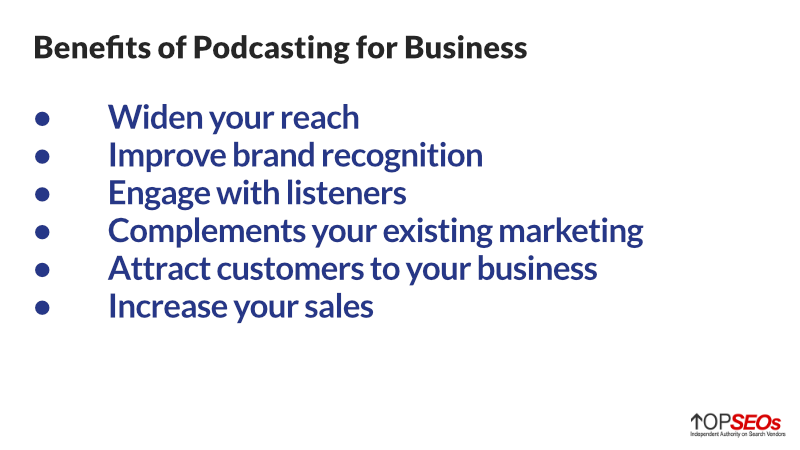
Widen Your Reach
Podcasts help you widen your reach. When you make your podcast available on multiple audio streaming platforms, you can tap into audiences that might not be following you elsewhere.
And, once listeners subscriber to your podcast, they’re more likely to keep listening and recommend your podcast to others.
FYI, podcasts are also a great way to get more backlinks to your site.
Improve Brand Recognition
Podcasts help you get your brand name out there and improve brand awareness. As people see your podcast come up in search results on audio streaming platforms, they’ll start recognizing your name and logo.
As your podcast gains popularity, so too will your brand.
Engage With Listeners
Podcasts are engaging. Listeners are able to get a better feel for the personality behind the brand and develop a connection on a more personal level.
Over time, this connection turns into a trust that makes listeners more likely to purchase your products and take your advice.
Complements Your Existing Marketing
Podcasts are a nice addition to your existing marketing efforts. You can use your podcast to promote your social media, website, and blog posts, as well as using it to promote your products and services.
You can also use podcasts to become a thought leader in your industry, especially if you bring on other authoritative guests.
Attract Customers to Your Business
Attracting customers is why most businesses start a podcast. As you continue producing high-quality, useful content, your listeners will become followers and trust your brand. When they trust you, they’re more likely to purchase your products and services.
Increase Your Sales
As you can probably tell from the other benefits we’ve discussed, podcasts can help you increase sales.
Yes, it takes time and effort to create and release high-quality content that will resonate with your target audience, but it’s worth it.
Your podcast can drive sales in several ways, including:
- Increasing brand recognition
- Boost your company’s reputation
- As an outlet to advertise your products
How to Start a Podcast for Your Business
If you’re not sure how to start a podcast for your business, we’re here to help. Here’s how to start a podcast in five easy steps.
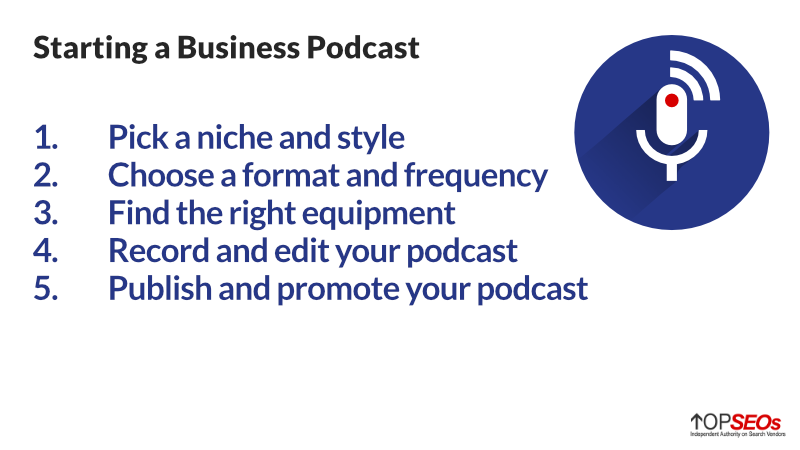
Step 1. Pick a Niche and Style
If you’re to the point in business development that you’re starting a podcast, you should already be well aware of who you are trying to reach. You’ll already have mapped out a customer journey and created buyer personas.
What you need to focus on now is what you’re going to share with that target audience.
It’s important to understand right off the bat that you can’t be everything to everyone. Choose a niche that is broad enough that you’re not going to run out of content, but narrow enough that you’ll pull in a targeted audience.
Choosing the right name is also important. You’ll want to make sure that your name lines up with your niche and that is descriptive and understandable. Unless you have strong name recognition already, like Marie Forleo or Gary V, stay away from using your own name in your podcast name.
As for your style, we’re talking about music and podcast art.
We recommend using intro and outro music that matches the feel of your show. You can find royalty-free, creative commons music to use so you’re not violating copyright laws.
If you have some money to spend and want music that nobody else has access to, you can hire a local musician to create music for your show.
Your podcast’s cover art is the first thing users will see when they’re searching on podcast apps, so it needs to be eye-catching and quickly communicate what your podcast is about. Don’t forget to use your logo!
Again, you’ll either want to create your own art, find creative commons artwork, or hire someone to create your podcast cover art for you.
Step 2. Choose a Format and Frequency
Podcasts come in many different formats. The most common are cohosted shows (with more than one host) and single host shows, with interview shows having solid representation, too.
Regardless of the format you choose to go with, make sure your content is engaging and useful.
In addition to your podcast format, you’ll want to consider episode length. Some podcast episodes last a mere few minutes, while others are monster, hours-long affairs.
The length of your podcast ultimately comes down to how much you have to cover. The average podcast is anywhere from 20–45 minutes, but you should test your length to find out what works best for your audience.
The last thing to consider is how often you’ll release a new episode. Some podcasters, like Chalene Johnson, release new episodes every day. This is fine if your episodes pack tons of value and are on the shorter side.
For longer podcasts, it makes more sense to limit new episodes to once a week.
Step 3. Find the Right Equipment
You can record a high-quality podcast with just a smartphone, but you’re going to be much happier with your audio quality if you use a high-quality microphone.
If your audio quality isn’t great, your podcast is going to suffer.
Think about it… if your written content was blurry and hard to read, nobody would want to read it, right?
The same goes for your podcast audio. If it’s garbage, your content isn’t going to have a chance.
Find a solid USB microphone that you can plug into your computer and don’t forget to think about your guests (i.e., buy enough mics).
Step 4. Record and Edit Your Podcast
Now that you have your equipment figured out, it’s time to find a quiet place to record your podcast. This will make things a lot easier when you’re trying to edit your podcast, too, as you won’t have as many ambient noises to worry about.
To record and edit your podcast, you’ll need an audio software. If you use a Mac, those typically come with GarageBand already installed. For Windows users, there are similar products you can use, like Audacity or Adobe Audition.
Step 5. Publish and Promote
Before you launch your podcast, you should start building buzz about it. You can do this by announcing the upcoming podcast on your blog, sending out an email to your email list, and letting your social media followers know it’s coming.
The goal is to generate interest and have an audience ready to listen from day one. Then, on launch day, you’ll want to have a few episodes reach to go. Be sure to ask listeners to subscribe and leave you a rating or review!
Podcast Statistics for 2020
Starting a podcast is exciting. It gives your business a chance to engage with your target audience in a new way and bring in a broader audience that may not hear of your brand otherwise.
But, developing a killer podcast strategy takes research.
Fortunately, we’ve done most of it for you. Here are some podcast statistics you can use to guide your podcasting strategy.
General Podcast Statistics
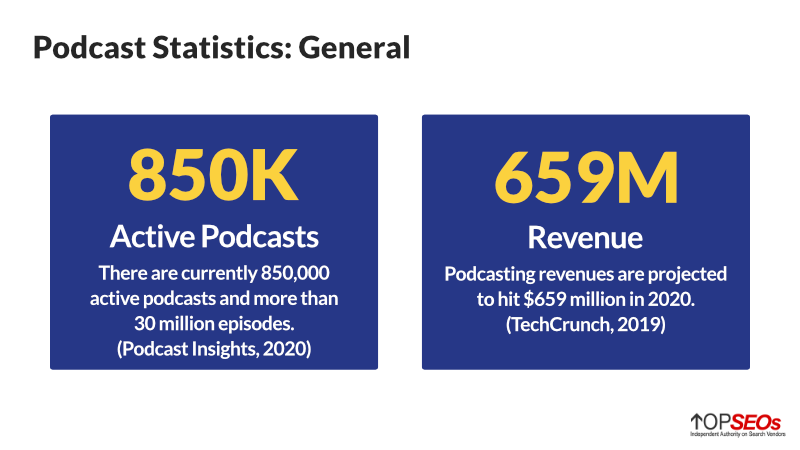
- There are currently 850,000 active podcasts and more than 30 million episodes (Podcast Insights, 2020).
- Monthly podcast listeners grew 16% from 2019 to 2020 (Edison Research, 2020).
- In the first ten months of 2019, 192,000 new podcasts launched (Inside Radio, 2019).
- Podcasting revenues reached $314 million in 2017 (TechCrunch, 2019).
- Podcasting revenues are projected to hit $659 million in 2020 (TechCrunch, 2019).
Podcast User/Usage Statistics
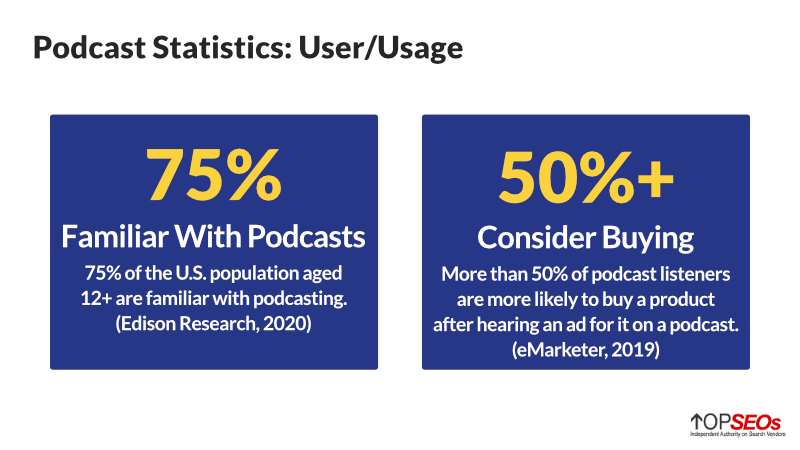
- More than half (55%) of U.S. consumers aged 12+ listen to podcasts (Edison Research, 2020).
- 75% of the U.S. population aged 12+ are familiar with podcasting (Edison Research, 2020).
- 37% of U.S. consumers aged 12+ have listened to a podcast in the past month.
- 24% of the U.S. population aged 12+ have listened to a podcast in the past week.
- According to Edison Research, podcast listeners are pretty much split evenly along gender identity with 39% of those identifying as men listening to podcasts and 36% of those identifying as women listening to podcasts (non-binary identities are currently not tracked).
- Podcasts are more popular with younger U.S. consumers with 49% of people aged 12–34 listening to podcasts compared to 40% of people aged 35–54 and just 22% of people aged 55+ listening (Edison Research, 2020).
- The average podcast listener spends 6:39 listening to podcasts each week (Edison Research, 2020).
- U.S. weekly podcast listeners averaged six podcasts in the last week (Edison Research, 2020).
- 65% of podcast listeners use smartphones, tablets, or other portable devices to listen (Edison Research, 2019).
- 75% of podcast listeners in the U.S. say they listen to learn new things (Statista, 2019).
- More than half of podcast listeners say they’re more likely to consider buying a product after hearing an ad for it on a podcast (eMarketer, 2019).
- The fastest-growing countries for podcasting are Chile, Argentina, Peru, and Mexico (Buzzsprout).
- 58% of South Koreans listen to podcasts (Buzzsprout).
- 83% of Australians are familiar with podcasts (Podcast Hosting).
- 12% of U.K. adults listen to at least one podcast each week (Podnews).
- Podcasts make up 10% of all content that Millennials listen to (Billboard).
- Podcast listeners are 68% more likely to have a postgraduate degree (Edison Research).
- 45% of podcast listeners have an annual household income greater than $250,000 (Music Oomph).
Podcast Advertising Statistics
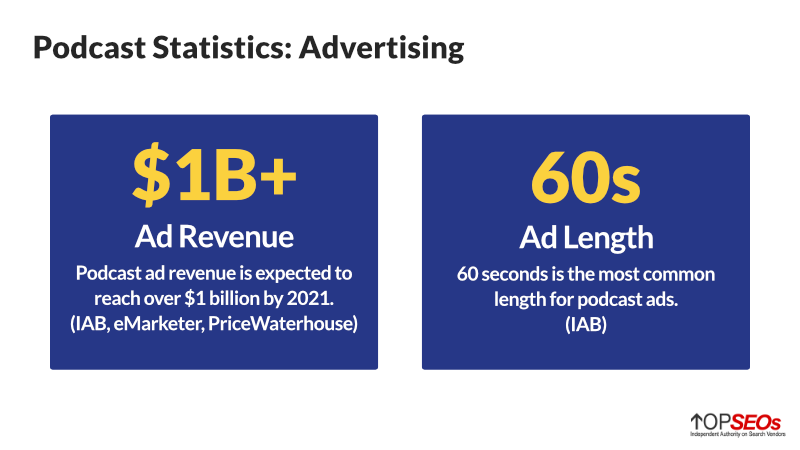
- According to the Internet Advertising Bureau (IAB), eMarketer, and PriceWaterhouse, ad revenue is expected to reach $679 million this year, increasing to $863 million in 2020 and over $1 billion by 2021.
- Popular podcasts can charge advertisers between $10 to $50 for every 1,000 listeners, approximately two or three times the ad rate for broadcast radio (Forbes).
- U.S. listeners are more receptive to ads on podcasts than any other medium, with 55% saying they always or sometimes pay attention to podcast ads (Business Insider, 2019).
- The total market revenue estimate for podcasting increased by 53% in 2018 (IAB).
- Host-read ads are the most preferred type of podcasting advisement (IAB).
- 60 seconds is the most common length for podcast ads (IAB).
Podcast Business Statistics
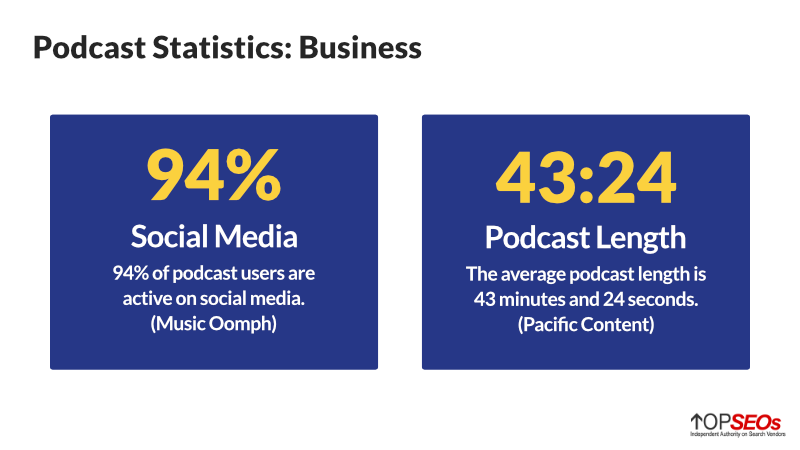
- 17% of podcasters record videos in addition to their podcasts (The Podcast Host Gear Survey 2019).
- 10% of podcasters live broadcast their podcast recording (The Podcast Host Gear Survey 2019).
- NPR is the leading podcast publisher with 23.75 Million unique monthly listeners (Podtrac).
- Apple is the preferred podcast provider among adults in the U.S. (Marketing Charts)
- The average podcast length is 43 minutes and 24 seconds (Pacific Content).
- 94% of podcast users are active on social media (Music Oomph).
- The best time to publish podcasts is Monday, Tuesday, and Wednesday (Music Oomph).
Wrapping Up
As you can see from the podcast statistics we’ve shared, podcasting is huge and it’s just getting more popular, particularly with Millennial and Gen Z audiences.
While podcasting can be a great marketing tactic for your business, you’ll need to do it right to fight through the noise of more than 850,000 podcasts that are already out there.
Fortunately, with the statistics and podcasting tips we’ve included here, you’re much better equipped to make that happen.
To create a solid podcast strategy, you need a solid digital marketing agency. Here’s a list of the best digital marketing agencies around to help you choose.




















